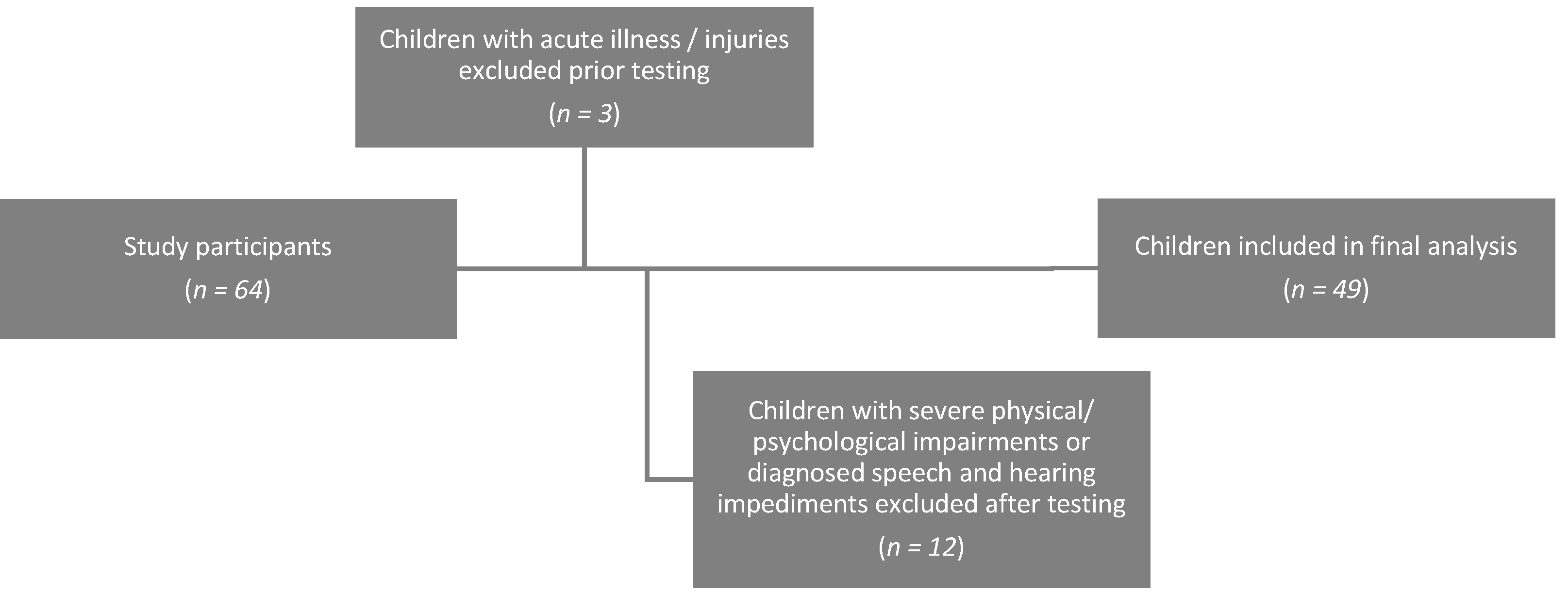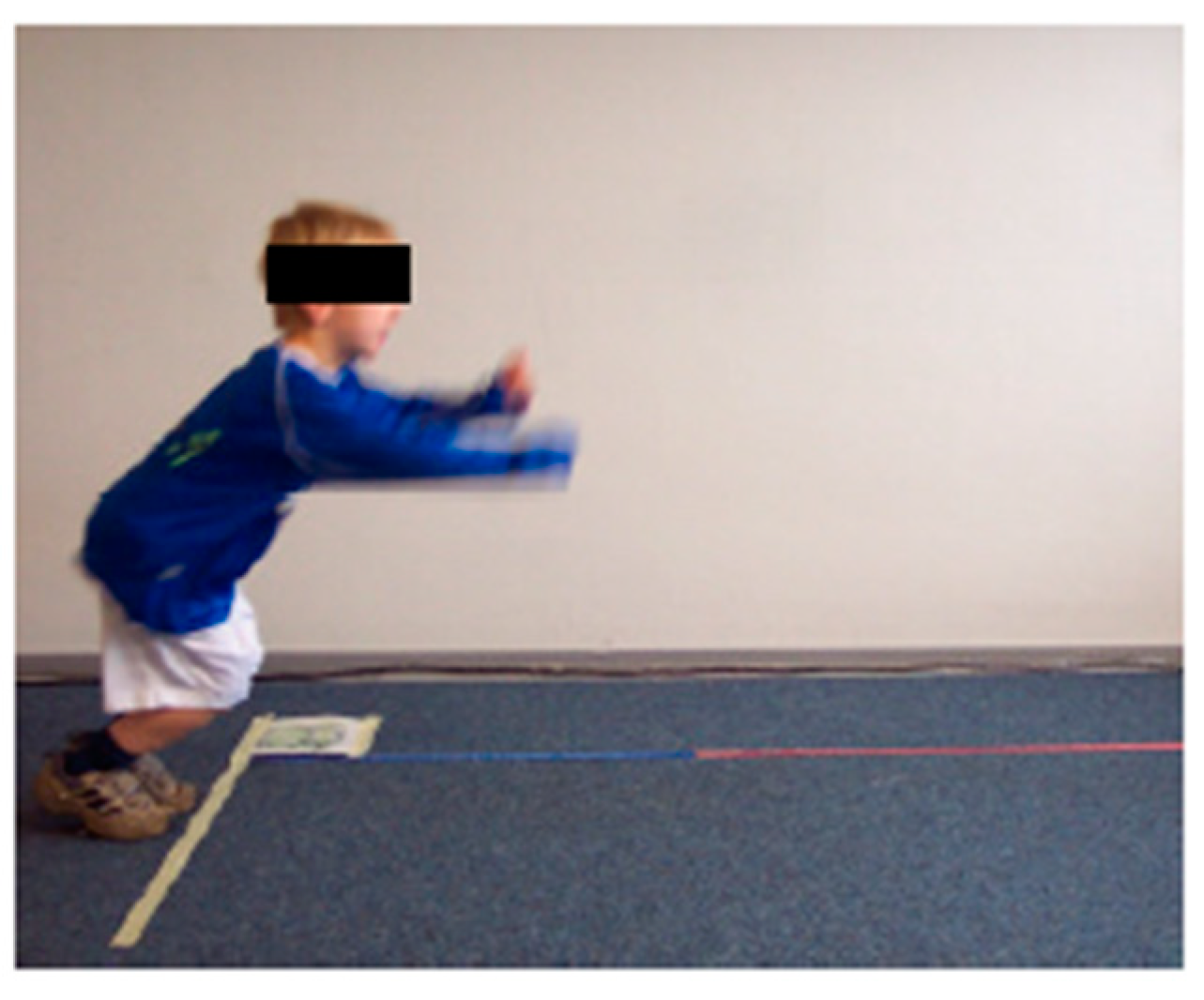1. Introduction
The modern lifestyle of children is characterised by increasing physical inactivity and media consumption [
1,
2,
3,
4,
5,
6,
7]. Even at preschool age, most children fail to reach the nationally and internationally recommended physical activity levels. In Germany, for example, only 42.5% of preschool-aged girls and 48.9% of preschool-aged boys achieve the 180 min of physical activity per day recommended by the WHO (World Health Organisation) [
2,
8,
9,
10] and health experts in Germany [
11]. Instead, 42% of the girls and 55% of the boys spend more than three hours a day during their early childhood years sitting still in front of screens [
12]. This excessive amount of screen time, in turn, may negatively affect motor skills [
13,
14,
15] and promote the development of body fat and visceral adipose tissue mass [
16], leading to excess body weight and obesity [
7].
A systematic review by Stiglic and Viner [
17] showed that an increased screen time was associated with reduced cardiorespiratory fitness, increased obesity, less prosocial behaviour, lower self-esteem, depressive symptoms and lower quality of life [
17]. Conversely, evidence indicates that physical activity in childhood improves fitness as well as motor skills [
13,
18,
19,
20,
21], reduces the prevalence of obesity [
22,
23,
24] and promotes physical and psychosocial development [
25]. In addition, physical activity and fitness in childhood are associated with better cognitive abilities [
26,
27,
28] and language development [
29,
30,
31].
However, research has yet to determine whether motor skills in childhood, as a surrogate parameter for increased physical activity, are also associated with language development. Therefore, this pilot study analysed the language development status in preschool children and its association with motor skills and leisure time behaviour (physical activity, media use time), while taking socio-demographic factors and excess body weight into account.
4. Discussion
This pilot study investigated the influence of various factors related to preschool children’s leisure time behaviour, selected sociodemographic data and selected medical risk factors on their motor skills and linguistic development. In general, this study confirmed the increase in inactivity and media use time in childhood shown in previous studies [
1,
4,
5,
6,
7,
9,
30], characterising modern children’s lifestyle. The negative consequences of this inactive lifestyle on children’s health and development are far-reaching and shown in several previous studies [
7,
17,
37], whereas vigorous physical activity was proved to enhance the physical and psychosocial development [
25], children’s motor skill abilities [
13,
18,
19,
20,
21] and decrease the prevalence of overweight [
22,
23,
24]. Additionally, there is broad evidence that being physically active plays an essential role in children’s cognitive development. In several previous studies children who showed a higher frequency of physical activity or better motor skills, achieved better results in individual cognitive development tests [
26,
27,
28,
29,
30,
31,
38,
39,
40]. Additionally, Davis et al. [
41] found a positive association between visual processing skills and fine manual control skills.
The possible effects of motor skills on certain areas of language development have not yet been properly researched. So far, correlations between motor skills, language and cognitive development have mostly been investigated when there was an existing pathology in one of these areas [
42,
43,
44,
45,
46,
47,
48,
49,
50,
51]. In this study, however, children with speech impediments or any medical impairments were excluded.
In our study, inactive children had poorer scores on all subtests of language development, compared to children who spent more time each week in structured activity at sports clubs. Furthermore, the weekly time of unstructured activity besides kindergarten and sports clubs had a positive influence on the language subtests ‘Formation of morphological rules’ and ’Phonological memory for non-words’. Wang et al. [
52] found a possible predictive positive association between the language performance at an early age and the development of later fine and gross motor skills in 11,999 three- to five-year-old children, not showing a significant unique correlation. In contrast to our study, the motor and linguistic development was only recorded by using maternal questionnaires. Our results regarding possible predictive effects of motor skills on language development showed a heterogeneous picture. Test items, which require strength, endurance and speed, in particular, showed no clear correlation with the results of the language development tests. In turn, children who achieved better results on the motor test ‘One-leg stand’ scored higher on the language tests ‘Formation of morphological rules’ and ’Phonological memory for non-words’. Children with better flexibility on the ‘Sit-and-reach’ and better motor skills on the ‘Lateral jumping’ also achieved higher scores in the subcategory ‘Understanding Sentences’. Among the essential requirements of the ‘Sit-and-reach’ and ‘Lateral jumping’ tests are good endurance and flexibility; the ‘One-leg stand’, meanwhile, demands strong coordination and concentration. This ability to concentrate is likewise essential for understanding and correctly performing language development tasks. Thus, cognitive abilities and a high level of concentration are essential for age-appropriate language learning. Language, in turn, is necessary to understand, learn and refine complex motor movements. For example, while a child can learn the general way of performing a one-legged stand by observing other children, he or she can optimise that performance via external linguistic support (e.g., an explanation of how the arms can be used for balance and why).
In contrast, children with a higher total weekly media use time scored higher on the ‘Formation of morphological rules’ but lower on the subtests ‘Understanding sentences’ and ’Phonological memory for non-words’. Anderson et al. [
53] previously reported a similar variable effect on children’s cognitive development. While children under two years of age showed negative developmental effects following high media consumption time, preschool-aged children showed varying negative and positive effects depending on their screen time overall, the social context when viewing and the type of programme they watch (e.g., educational programmes for children vs. entertainment programmes for children). In our study, computer and game console time, in particular, was associated with better results on the ’Phonological memory for non-words’ and ‘Understanding sentences’ subtests. Because this study conducted no differentiated recording of the participants’ content-related PC and game console use, the extent to which educational games could have served as a positive influencing factor remains speculative at present. A study by Thorell [
54], for example, found that preschool children’s working memory improved after they participated in computer-based training. On the other hand, studies have also linked television-only screen time (i.e., watching TV rather than playing video games) with deficits in language development, a decrease in cognitive performance [
53,
55,
56,
57] and an increase in obesity [
58].
Increased BMI, in turn, is negatively associated with cognitive and motor development in 3.5- to 7-year-old children [
59]. Associations with language development have not yet been investigated. In our analysis, children who were overweight scored significantly lower on the ‘Formation of morphological rules’ and ’Phonological memory for non-words’ language subtests. However, being overweight per se is presumably not a risk factor for poor language development, it is associated with increased television consumption, lack of exercise and a lower level of parental education [
60,
61]. In our analysis, the social status, as well as the educational level of the parents, was also negatively associated with the language development status of the children. Niemistö [
62] and the KiGGS wave 2 [
10] also demonstrated these findings a positive correlation between a middle or high socioeconomic status and the motor skills in young children. Better financial status of the parents and growing up in an environment where children have easier access to learning materials seem to promote children’s development.
5. Strengths and Limitations
In this pilot study, the relationship between preschool children’s motor skills and language development was further investigated. The consideration of only selected subtests of the SETK 3–5, as well as the small sample, are limiting factors of this study. This must be taken into account when interpreting the results.
Overall, however, the present study found a positive correlation between movement and language in preschool-aged children. The study also highlighted the differentiated influence of screen media; educational games may represent a superior alternative to ‘parking the child in front of the television’.
6. Conclusions
Considering all these results, it seems to become more and more important to regard the correlation between all aspects of children’s development and how they affect each other, starting with good cognitive abilities and therefore high concentration skills to be able to develop a greater language ability as a precondition to understand and learn more precise motor coordination movements.
Despite the small sample size, the results of this pilot study serve as a starting point for future studies with larger samples to examine these potential connections between language development and motor skills in childhood. While the small number of participants, especially three-year-old participants, prevented the present study from including all language development tests in its final analysis, future studies should include them to facilitate specific statements about the relationship between individual aspects of language development and motor skills.
However, the results of the present study already underscore the complexity of child development and the close interconnection of cognitive, linguistic and motor skills as well as their great variability of potential positive and negative influencing factors. Therefore, the connection between rising inactivity, increased media consumption, an increased amount of overweight and obese children and the resulting motor deficits should play a more important role as a starting point for future preventive and promotional measures in childhood. These influencing factors—and their connections to motor skills and language development—should also be analysed in greater detail within the framework of larger study groups to further verify the results of this pilot study and possible correlations.













